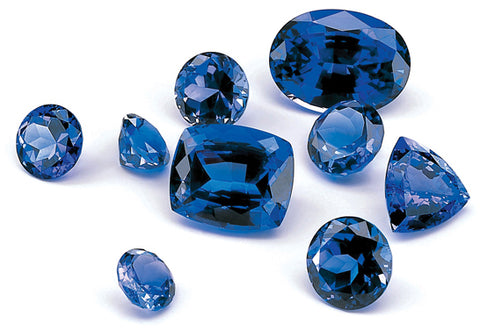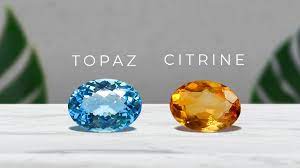Sapphire: Facts on the September Birthstone
Sep 04 2017 0 Comments Tags: birthstone, gemstones, sapphire, september
Now that it's September, it's time to give you some useful information and interesting facts about this month's birthstone: sapphire!

How did sapphire get its name?
Sapphire is a variety of the mineral corundum: although corundum is not rare in itself, gem quality corundum is much less common. The name 'corundum' is from Sanskrit, and its meaning is 'ruby sapphire'. The name 'sapphire' is thought to come from the Persian word 'safir', which is in turn derived from the Greek word for the colour blue. In the past, the term 'sapphire' was used to describe lapis lazuli, but by the nineteenth century the term was more commonly used to describe the corundum variety of sapphire that we are familiar with today.
Identifying a sapphire
Sapphire is any form of gem-quality corundum, other than red (which is the ruby). Next to diamond, it is the second hardest mineral on earth.
Sapphire lacks cleavage, but it can exhibit an uneven fracture. It belongs to the trigonal crystal system, structured with four axes and three planes of symmetry. However, the crystal form may vary depending on the origin of the specific gem.
Sapphire is easy to distinguish from other similar-looking gems (such as beryl, zircon, tourmaline and others) by its superior hardness and durability. This is in spite of the fact that many other gemstones share a similar colour and lustre.
Gemological properties
 Mineral: Corundum
Mineral: Corundum
Chemistry: Al2O3 (aluminum oxide)
Crystal System: Hexagonal
Density/Specific Gravity: 3.95 - 4.03
Mohs Hardness: 9
Refractive Index: 1.762 - 1.788
Birefringence: 0.008
Buying a sapphire
Sapphire colour
As you might expect, blue is the most famous and valuable colour variety of sapphire. Burmese and Kashmir sapphires, not often seen on the market today, are highly prized for their intense blue colour. Today, Sri Lankan and Madagascar sapphires are the most common, and these range in colour from light to dark blue.
The intensity of blue is the most important factor in the desirability of a blue sapphire. A small stone with excellent colour will generally fetch a higher price than a huge stone with a washed-out colour. A rich, bright blue is the most desirable colour, rather than a blue that is too dark and inky, or too washed-out. However, a lighter blue may possess a greater brilliance that is not generally found in darker stones. Colourless sapphires are fairly rare, as there will be at least a hint of colour in most stones. Blue is considered the default colour when referring to sapphires, and all other colours are called 'fancy sapphire'.
Trace impurities are the colouring agents in sapphires, which in blue sapphires are generally iron and titanium. Other colours of sapphire are formed by different minerals, or minerals in different trace amounts. Heat treatment can product an intense golden yellow colour, and beryllium treated sapphires can be a brilliant bright yellow. Padparascha sapphires are a pinkish-orange colour, and are particularly rare and prized by collectors.
Natural daylight is the best way to view sapphires, as artificial light can make them appear darker. It can even make them appear less attractive than they actually are in natural light.
Sapphire clarity and lustre
Sapphire can be transparent to opaque, but transparent gems are the most valuable. Some translucent materials will be cut into beads or cabochons instead of gems, but opaque materials have very little gemstone value. Sapphires have an attractive, vitreous lustre.
Sapphires, as a rule, are cleaner than ruby, and it is thus possible to find eye-clean stones. However, large eye-clean stones in ideal colours can be quite rare. In some cases, extremely fine silk through the stone can enhance the value of a sapphire, as it can cause a velvety blue colour and the asterism seen in star sapphires. However, too much silk gives the gem a greyish hue and thus renders it undesirable.
Sapphire treatment
Heat treatment is the most common treatment for sapphires, but unheated specimens can also be found. Stones are heated - usually before they are cut - to between 1700 and 1800 degrees Celsius for several hours. Rich blue, unheated stones can command very high prices, as the vast majority of sapphires today are heat treated. Occasionally, diffusion treatment is used, but this is more common for star sapphires. Beryllium is used to treat sapphires to create bright orange and yellow colours that used to be very uncommon. However, all sapphire treatments should be disclosed by the dealer.
Gemstone care
The best way to clean sapphire is using a soft cloth or brush and warm, soapy water. It should then be rinsed to remove residue. Avoid using harsh household cleaners on your sapphire, as these might cause corrosion. In addition to this, extreme heat fluctuations can cause your sapphire to change colour.
Sapphire jewellery, as with all jewellery, should be removed before playing sports in order to protect it. When you are storing sapphire gemstones, wrap them in a soft cloth and/or keep them inside a fabric-lined jewellery box.
Sapphire history and lore
Sapphire is the September birthstone, and is considered to be the stone for Taurus. For those who believe in the healing power of gemstones, wearing a sapphire is thought to protect a Taurus's mental health.
The sapphire has been used to symbolise truth, sincerity, loyalty and peace throughout history. It has also been believed to be a talisman to protect against evil spirits. Star sapphires used to be regarded as charms to protect travellers, and were considered so powerful that their protective power would continue even when the sapphire had been passed on to another owner.
Large sapphires of an ideal colour are rare, and often attract significant attention. The largest star sapphire is the Star of India, which weighs an astounding 536 carats. It was discovered three hundred years ago in Sri Lanka, and donated to the American Museum of Natural History. It was stolen in 1964, but its recovery only a few months later added to its fame.
The Logan Sapphire is a 423 carat sapphire that is displayed in the Smithsonian Museum of Natural History, and it is the largest known blue sapphire and the largest faceted sapphire on public display. It is currently set in a brooch, surrounded by diamonds. It was donated to the Smithsonian by Mrs. John A. Logan in 1960.

The English Crown Jewels also contain two famous sapphires: the St Edward's and the Stuart sapphire, which have a combined weight of 104 carats.
Sapphire jewellery
Sapphire is a very popular gemstone for jewellery, as it is one of the 'precious four' gems. This also includes ruby, green emerald and diamond, and these four gems are thus frequently used for fine jewellery. Sapphire, alongside diamond, is one of the most popular gemstones worldwide; it is frequently used for brooches, pendants, rings, necklaces, earrings and more. It is also an excellent gemstone carving material (and this is occasionally what the less valuable, opaque stones are used for).
Lots of different shapes and cutting styles can be used with sapphires. Ovals, cushions and rounds are common, but hearts, pears and emerald cuts can also be found. Round stones can command high prices, especially in stones weighing 1 carat or more. Cabochons and beads are common uses for translucent stones or those with visible inclusions.
Sapphire prices vary hugely depending on the quality of the gemstone, so they can be found in a variety of price ranges from costume jewellery to high-end designer pieces. Untreated sapphire is very rare and expensive, but treated sapphire can be quite affordable.
Related gems
As sapphire is a gem-quality variety of corundum, it is closely related to the ruby (which is also a corundum gem, but is distinguished by its red colour. See below for a picture of a cut ruby with inclusions). Generally, sapphires of other colours are called colour-specific names, such as 'yellow sapphire' etc. There is also colourless sapphire, which is sometimes known as 'leuko-sapphire'.
Because of the wide variety of sapphire colours, it is easily confused with other coloured gemstones such as zircon, beryl, chrysoberyl, spinel, tourmaline and quartz. However, sapphire's superior hardness and durability can distinguish it from other coloured gemstones. It is the second hardest substance on earth, after diamond, and is rated 9 on the Mohs scale.
0 comments







Leave a Comment